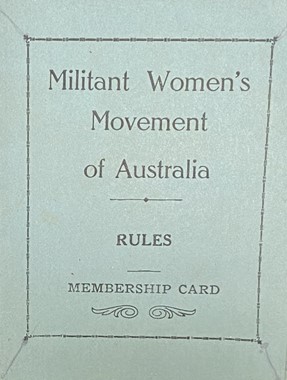newsletter from Sydney Trades Hall home to the largest collections of trade union historical memorabilia in Australia
This Month we look at the AIDS crisis and the union response; same sex superannuation entitlements; International Women's Day in the 1920s; and the South Australian Working Women's Centre
Fifty Years of Fighting

Part of the exhibition was of course the AIDS crisis and the massive response to it. Unionists were in the frontlines then, as now with COVID.
AIDS was described by religious groups as the gay plague. It was a worldwide calamity that took many lives and made many very ill. Unions acted around the word to make workplaces safe AND sought to counter the false information on how it was spread. Collective action to protect all.
For union responses through history to epidemics and threats to public health check out this article from Trades Hall
Geraldine Fela in ‘Blood Politics: Australian Nurses, HIV and the Battle for
Rights on the Wards.’ Labour History, no. 115 (2018): 87-104 said:
Nurses and their unions in NSW and Victoria played a progressive, sometimes radical, role in the AIDS crisis. Stories of AIDS patients left untended and untouched by fearful and prejudiced nurses are not uncommon, nor are they untrue. But on hospital wards and in clinics, fear and prejudice were not ubiquitous: these ideas were contested by the politics of solidarity and collaboration. Both union officials and rank-and-file members acted in solidarity with HIV/AIDS patients and fought for their rights in medical institutions and the outside world. In these moments, there are echoes of the “social movement unionism” exemplified by the radical New South Wales Builders Labourers’ Federation (NSW BLF) in the 1970s. This reflected the emerging industrial radicalism of nurses in this period and their growing confidence to challenge their traditionally subordinate role in the hospital hierarchy, a role shaped by the fact that nursing was and remains a highly feminised profession.
See also
https://www.afao.org.au/wp-content/uploads/2018/12/HIV-Australia_-Geraldine-Fela.pdf
Geraldine won the ALGA Prize for her honours thesis in this area and the 2017 Eric Fry Labour History Research Grant and in 2021 the Joan Hardy Scholarship for Post Graduate Nursing Research.
AIDS brought urgency to the push for decriminalisation – this had to happen to make it safe for gay men to get tested. It also brought a stronger push for anti discrimination protection as the LGBTIQ community faced significant hostility and fear in areas like housing, medical treatment, employment.
Almost as soon as AIDS arrived in Australia, nurses unions began working on policies and procedures for their members that recognised the rights of workers & their patients.
The Victorian Trades Hall Council (VTHC) negotiated a health and safety agreement for health workers that was the basis for work-related AIDS policies adopted around the country.
Gay union activists led several trade unions to adopt policies on HIV with regards to pensions and discrimination. Several unions also developed prevention education materials and resources for their members.
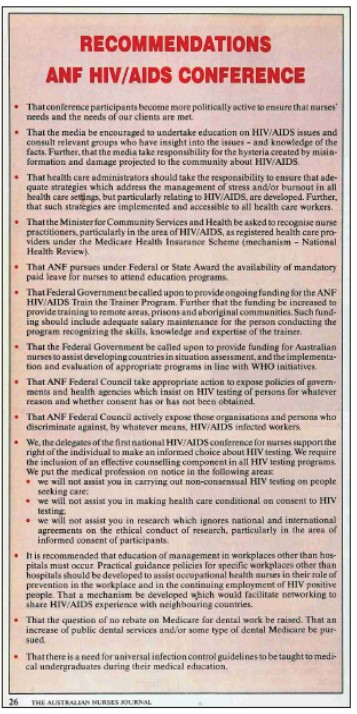
Australian unions stepped up quickly with education programs around AIDS, and information campaigns to stem the hysteria and discrimination.

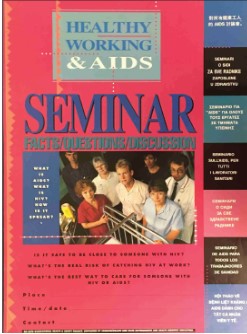
Equal Rights to Superannuation and death benefits were also pushed to the front of mind with the AIDS crisis.
1998-99 Superannuation Rights for Same Sex Couples
Discrimination for Same Sex Relationships in 1998 following changes to definition of marriage meant that same sex couples were excluded. Funds could refuse to pay a joint pension or a lump sum on retirement; On death of a contributor they could refuse death benefits, and refuse payments for children of same sex couples. Also tax treatment was different as heterosexual couples saw benefits taxed at the concessionary rate but with same sex couples if funds are part of the estate of the deceased then they would be taxed at the higher rate.
The issue was raised with the federal LNP Government in 1998.

A private members Bill was moved in federal Parliament by Anthony Albanese, then in Opposition, calling for changes. The Bill was the Superannuation (Entitlement of Same Sex Couples) Amendment Bill. Albanese pushed repeatedly for these changes over the next few years.
This was unsuccessful until the ALP was elected to Government in 2007. The Same-Sex Relationships (Equal Treatment in Commonwealth Laws – Superannuation) Bill 2008 was introduced in 2008 and the Human Rights Commission made a submission based on the many submission to their own inquiry of 2007.
The Human Rights Commission examined the discrimination against same sex partners in their report in 2007
The found that 58 federal laws denied same-sex couples and their children basic financial and work-related entitlements available to opposite-sex couples and their children.
Commissioner Graham Innes said “As one man told us during our Inquiry - same-sex couples are first class tax-payers but second class citizens - and we have certainly found this to be true,”
“This discrimination is completely unfair. There are 58 federal laws breaching the most fundamental of human rights principles – non-discrimination, equality before the law and the best interests of the child.”
The Gay and Lesbian Rights Lobby (NSW) told the Inquiry that:
Despite a commitment from the Government, public sector funds have not incorporated the category of ‘interdependency’, meaning that public sector and military employees who are in a same-sex relationship cannot nominate their same-sex partner of their beneficiary for any super death benefits. Instead they must distribute their benefit to their partner through their estate, which attracts a higher rate of tax.
As Tony Whelan said very clearly in a submission to the inquiry:
Given the age of my partner and myself, the possibility of one of us dying in the next ten years is not insignificant. If that happens, the surviving partner will not receive any death benefit payments from the deceased partner’s superannuation. I could accept that if other members of those schemes faced the same dilemma, but of course they do not. Former military or public service members who have a partner of the opposite sex automatically receive death benefit entitlements... Granting me and my partner superannuation death benefits will not bring about the collapse of my neighbours’ marriages, nor lower their income, nor make their roses wilt. There is no logical reason to maintain this discrimination; it is being maintained out of ideological spite... We are all citizens and there should not be one superannuation law for my brother and a different superannuation law for me.
The Government's same-sex law reform package passed through Parliament in November 2008.
The reform removed discrimination against same-sex de facto couples and their families in areas such as taxation, superannuation, social security and family assistance, the Pharmaceutical Benefits Scheme Safety Net and the Medicare Safety Net, aged care, veterans' entitlements, immigration, citizenship and child support and family law.
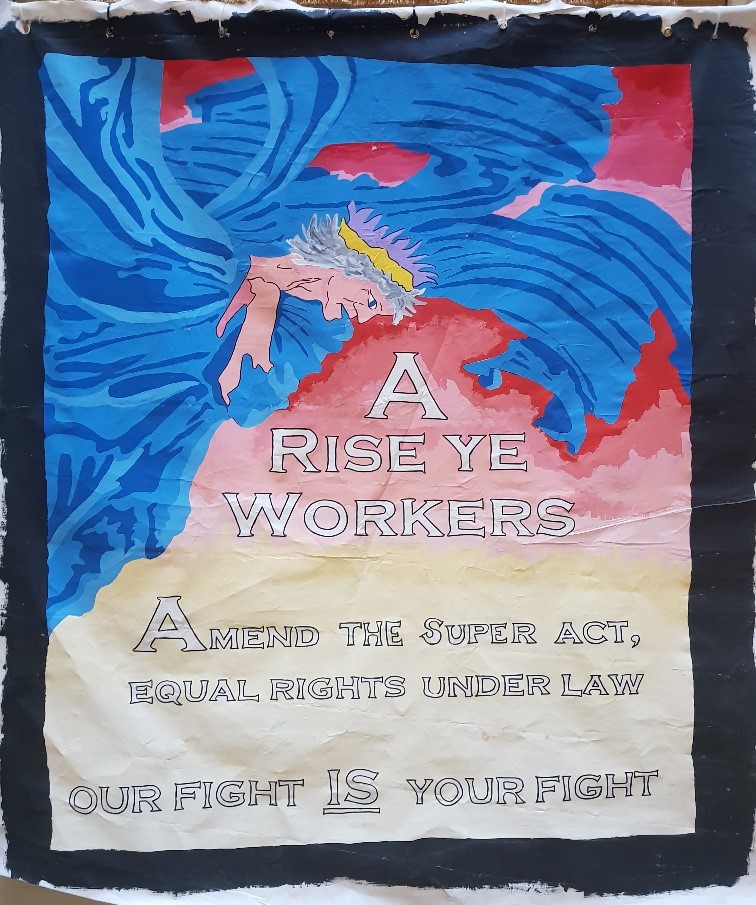
Banner demanding equal super rights for same sex couples, made in 2002 with artwork and design by Karen Askew, with assistance from Robyn Fortescue and Michelle Rosicki.
International Women’s Day 1928 saw women having the first marches in Australia.
The Militant Women’s group was established by Communist Party women in 1927.

Joyce Stevens says the first Australian IWD rally took place in the Sydney Domain on March 25, 1928. It was organised by the Militant Women's Movement and called for equal pay for equal work; an 8-hour day for shop girls; no piece work; the basic wage for the unemployed and annual holidays on full pay. The driving factor was the Bruce Federal Governments anti Trade Union legislation.

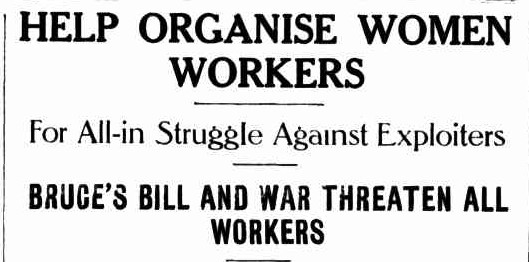
Workers Weekly 23 March 1928

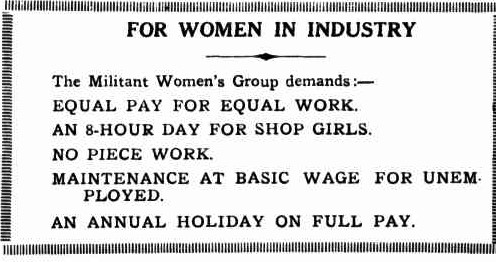
The reports from Workers Weekly following the rally were a little muted!
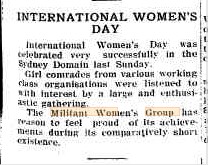
However women were organising in the workplace, as the paper reported:
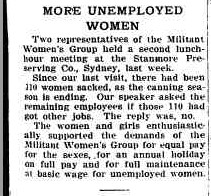
A Militant Women’s Group formed in Melbourne on the 23rd:

Workers Weekly 23 March 1928
The Weekly Times (31 March 1928) reported that the Melbourne Eight Hours March had a contingent from the Militant Women’s Group:

The Workers Weekly also reported:
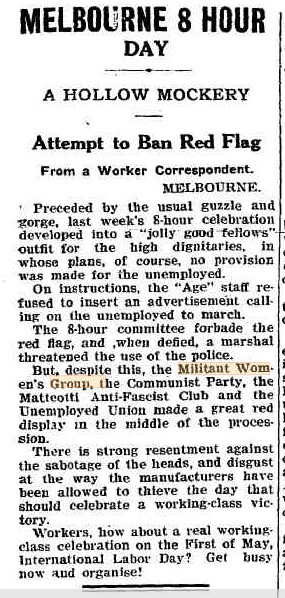
Workers Weekly 6th April 1928
and from Labour Call 12 April 1928

Later in 1928 the first issue of The Woman Worker was issued.
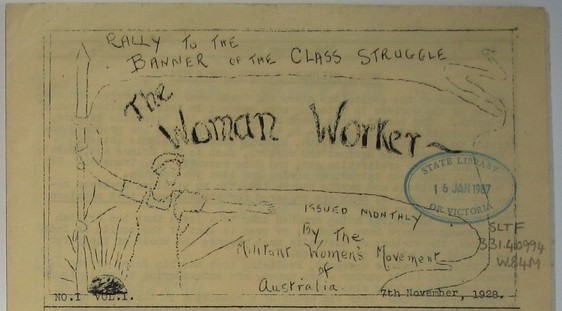
First issue of The Woman Worker 7 November 1928 at Reason in Revolt
1929 saw Militant Women organise on International Women’s Day and support the timber workers strike that was a large scale attack on all workers rights.
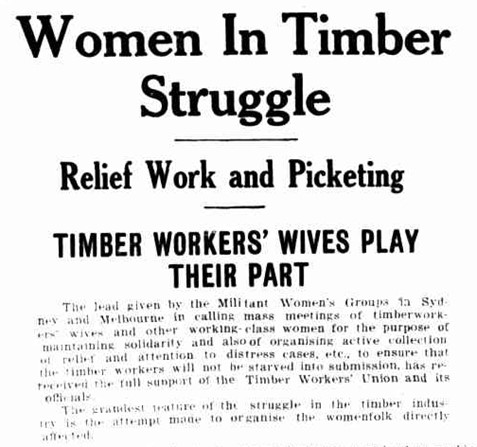
Workers Weekly 8th March 1929.
“On 8 March 1929, the Militant’s Women’s Group organised a second International Women’s Day rally at Belmore Park to support the wives and children of the striking timber workers. They also stormed the offices of the Timber Merchants Association, leaving its Secretary, Mr F H Corke ‘pale and trembling’. See Trades Hall Press from January 2022
The groups kept going through the harsh times

Workers Weekly 10 January 1930

Workers Weekly 13 March 1931
The Noel Butlin Archive holds some great material on the Militant Women’s Movement. See their online exhibit on 100 years of the CPA
For an excellent history of International Women’s Day (very Sydney based as the author says) go to Joyce Stevens book online
There is a good article on Red Flag
South Australian Working Women’s Centre
We were Adelaide recently and coincidentally we were staying very close to the South Australian Working Women’s Centre. The Centre was set in motion in a meeting at Adelaide Trades Hall in December 1978. Their T Shirt honours the caravan they worked out of in their early years. Here is the initial Chair Deborah McCulloch and some man with the van.

And the T Shirt

“In 1979 the Working Women’s Centre SA Inc was born. Our first home was a 1976 HJ Holden. Shortly after we upgraded and our headquarters became the now iconic caravan. In 2019 the Working Women’s Centre reached our 40th birthday and in celebration of this achievement we released a special limited edition of merchandise to commemorate 40 years of empowering working women in South Australia.
We collaborated with local artist, unionist & feminist Catherine Story, who created this design featuring a screenprinted illustration of the iconic caravan, honouring our unique grassroots beginning.
You can view more of Cath’s work on her Instagram account @Cathstorydraws “
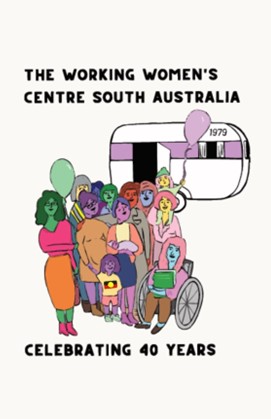
Billy Bragg was in Adelaide for WOMAD and spent a bit of time with unionists, especially the Working Women’s Centre. I found out about the WWC socks via photo of him wearing them! He gave them an excellent boost on stage. A bit of the clip here: https://www.facebook.com/watch/?v=5941765025907152
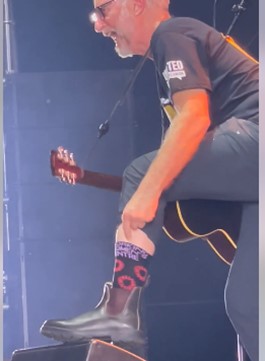
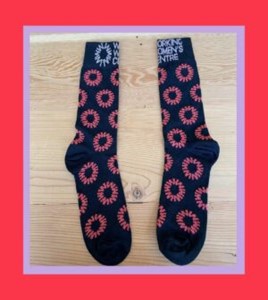
You can get all their swag here via their website https://wwcsa.org.au/shop/
Support a great cause and help them stay open.
Penny Sharpe, part of the incoming ALP government in NSW, says they will re-establish a Working Women’s Centre in NSW. Let’s see.
All newsletters on line.
Real life tours can be organised with Neale via ntowart@unionsnsw.org.au

